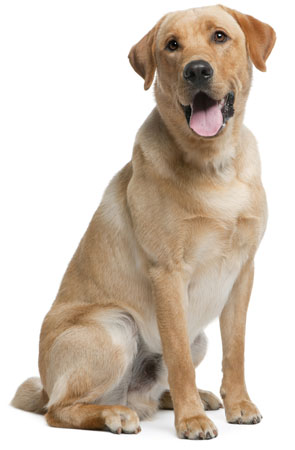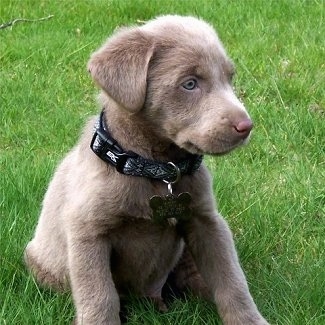
Labrador Retriever

Labrador Retriever

Labrador Retriever

Description | There are two types of Labradors, the English Labrador and the American Labrador. The English bred lab comes from English bred stock. Their general appearance is different. The English bred labs are heavier, thicker and blockier. The American bred Lab comes from American bred stock and is tall and lanky. The Labrador Retriever is a solid, muscular dog, slightly longer than tall, with a short, hard, easy-care, water-resistant double coat that does not have any waves and comes in solid black, yellow, or chocolate. There is also said to be a rare silver or gray color that is referred to by the AKC as a shade of chocolate. This color is controversial and some claim it is a Weimeriner cross, while others say it is a true mutation. The Labrador has a broad head, thick nose, scissors bite and a pronounced stop. Its muzzle is fairly wide and its neck is powerful. The eyes are chestnut or hazel with an intelligent expression. The medium-sized ears are pendant. The otter tail is strong, thick near the body then tapering, and completely covered with hair. Its limbs have good bone structure. The webbed feet aid in swimming. |
| Temperament | The Labrador Retriever is a loving, affectionate, lovable, patient dog. Highly intelligent, loyal, willing, and high-spirited. Lively and good-natured, they love to play, especially in water - for they love to swim. They have an excellent, reliable, temperament and are friendly, superb with children and equable with other dogs. They crave human leadership and need to feel as though they are part of the family. Labs are easily trained. Some may be reserved with strangers unless very well socialized, preferably while they are still puppies. These dogs are watchdogs, not guard dogs, although some have been known to guard. They can become destructive if the humans are not 100% pack leader and/or if they do not receive enough mental and physical exercise, and left too much to their own devices. Train Labradors early not to pull on the leash, as they have very strong necks. Show lines are generally heavier and easier going than field lines. Field lines tend to be very energetic and will easily become high strung without enough exercise. Often the best pets are from combination show/field stock. This breed is very popular. If you are planning to show, buy only from a reputable breeder. Some of their talents include: hunting, tracking, retrieving, watchdog, police work, narcotics detection, guide for the blind, service dog for the disabled, search and rescue, sledding, carting, agility, and competitive obedience. Labs bred from English lines (English Labs) are more calm and laid back than Labradors bred from American lines. English Labs mature quicker than the American type. |
| Height, Weight | Height: Dogs 22-24 inches (56-61cm.) Bitches 21-23 inches (53-58cm.) Weight: Dogs 60-75 pounds (27-34kg.) Bitches 55-70 pounds (25-32kg.) Some males can grow to 100 pounds (45kg) or more. |
| Health Problems | Prone to hip and elbow dysplasia, PRA and eye disorders. |
| Living Conditions | Labrador Retrievers will do okay in an apartment if sufficiently exercised. They are moderately active indoors and will do best with at least an average-sized yard. |
| Exercise | Labrador Retrievers are energetic dogs, delighted to work and play hard. They need to be taken on a daily, brisk, long walk, jog or run alongside you when you bicycle. While out on the walk the dog must be made to heel beside or behind the person holding the lead, as in a dog's mind the leader leads the way, and that leader needs to be the human. They will be in their glory if you give them a job to do. Labs are big eaters and need regular exercise and moderate rations to avoid a tendency to become overweight. |
Life Expectancy | About 10-12 years |
Grooming | The smooth, short-haired, double coat is easy to groom. Comb and brush regularly with a firm, bristle brush, paying attention to the undercoat. Bathe or dry shampoo only when necessary. These dogs are average shedders. |
| Origin | Once known as the "St John's Dogs," the Labrador Retriever is one of the most popular breeds in the United States. Originally from Newfoundland, Canada the Labrador was trained to jump overboard into the icy waters to haul fisherman's nets to shore. Specimens were brought to England in the 1800's by English ships coming from Labrador, where the dog's fine retrieving instincts were honed and developed. One of the best family dogs and canine companions because of their gentle, loving disposition, the highly trainable Labrador also excels in drug detection, as a guide for the blind, and service dog for the disabled. The breed is also an outstanding obedience and field trial competitor. |
| Group | Gun Dog, AKC Sporting |
| Recognition | CKC, FCI, AKC, UKC, KCGB, CKC, ANKC, NKC, NZKC, CCR, APRI, ACR |

No comments:
Post a Comment